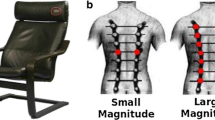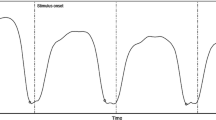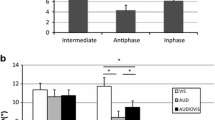Abstract
People commonly move along with auditory rhythms in the environment. Although the processes underlying such sensorimotor synchronisation have been extensively investigated in the previous research, the properties of auditory rhythms that facilitate the synchronisation remain largely unclear. This study explored the possible benefits of a continuity matching between auditory pacers and the movement produced as well as of a spatial pattern matching that has been previously demonstrated with visual pacers. Participants synchronised either finger tapping or forearm oscillations with either discrete or continuous pacers. The pacers had either a spatial pattern (left–right panning) that matched the movement pattern produced or no spatial pattern. The accuracy and variability of synchronisation were assessed by the mean and standard deviation of the asynchronies, respectively, between participant’s movement and the pacers. Results indicated that synchronisation was more accurate and less variable for discrete pacers and continuous movement (i.e., forearm oscillations). The interaction between those two factors involved a more complex relationship than a simple continuity match benefit. Although synchronisation variability increased with continuous pacers for both types of movement, this increase was smaller for continuous movement than discrete movement, suggesting that continuous movement is more beneficial only for continuous pacers. Moreover, the results revealed limited benefits of spatial pattern matching on auditory-motor synchronisation variability, which might be due to lower spatial resolution of the auditory sensory modality. Together, these findings confirm that sensorimotor synchronisation is modulated by complex relations between pacer and movement properties.


Similar content being viewed by others
References
Armstrong A, Issartel J (2014) Sensorimotor synchronization with audio-visual stimuli: limited multisensory integration. Exp Brain Res 232(11):3453–3463. https://doi.org/10.1007/s00221-014-4031-9
Armstrong A, Issartel J, Varlet M, Marin L (2013) The supplementation of spatial information improves coordination. Neurosci Lett 548:212–216. https://doi.org/10.1016/j.neulet.2013.05.013
Brainard D (1997) The psychophysics toolbox. Spat Vis 10(4):433–436. https://doi.org/10.1163/156856897X00357
Cohen J (1988) Statistical power analysis for the behavioural sciences, 2nd edn. Academic Press, New York
Conway CM, Christiansen MH (2005) Modality-constrained statistical learning of tactile, visual, and auditory sequences. J Exp Psychol Learn Mem Cognit 31(1):24. https://doi.org/10.1037/0278-7393.31.1.24
Eerola T, Luck G, Toiviainen P (2006) An investigation of pre-schoolers’ corporeal synchronization with music. In: Proceedings of the 9th international conference on music perception and cognition. The Society for Music Perception and Cognition and European Society for the Cognitive Sciences of Music Bologna, pp. 472–476
Elliot MT, Wing AM, Welchman AE (2009) Being discrete helps keep to the beat. Exp Brain Res 192(4):731–737. https://doi.org/10.1007/s00221-008-1646-8
Faul F, Erdfelder E, Lang AG, Buchner A (2007) G* Power 3: a flexible statistical power analysis program for the social, behavioral, and biomedical sciences. Behav Res Methods 39(2):175–191
Franz VH, Loftus GR (2012) Standard errors and confidence intervals in within-subjects designs: generalizing Loftus and Masson (1994) and avoiding the biases of alternative accounts. Psychon Bull Rev 19(3):395–404. https://doi.org/10.3758/s13423-012-0230-1
Hommel B (1996) SR compatibility effects without response uncertainty. The Quarterly Journal of Experimental Psychology: Section A 49(3):546–571
Hommel BE, Prinz WE (1997) Theoretical issues in stimulus-response compatibility. In: Symposium on the theory of SR Compatibility, Jun, 1995, Benediktbeuern, Munich, Germany; The contributions to this book are the fruits of the aforementioned conference. Elsevier Science/JAI Press
Hove MJ, Keller P (2010) Spatiotemporal relations and movement trajectories in visuomotor synchronization. Music Percept 28(1):15–26. https://doi.org/10.1525/mp.2010.28.1.15
Hove MJ, Fairhurst MT, Kotz SA, Keller PE (2013) Synchronizing with auditory and visual rhythms: an fMRI assessment of modality differences and modality appropriateness. Neuroimage 67:313–321
Iacoboni M, Woods RP, Mazziotta JC (1998) Bimodal (auditory and visual) left frontoparietal circuitry for sensorimotor integration and sensorimotor learning. Brain 121(11):2135–2143
Jolliffe IT (2002) Principal component analysis, 2nd edn. Springer, New York
Lenc T, Keller PE, Varlet M, Nozaradan S (2018) Neural tracking of the musical beat is enhanced by low-frequency sounds. Proc Natl Acad Sci 115(32):8221–8226
Lesaffre M, Voogdt LD, Leman M, Baets BD, Meyer HD, Martens JP (2008) How potential users of music search and retrieval systems describe the semantic quality of music. J the Assoc Inf Sci Technol 59(5):695–707
Lorås H, Sigmundsson H, Talcott JB, Öhberg F, Stensdotter AK (2012) Timing continuous or discontinuous movements across effectors specified by different pacing modalities and intervals. Exp Brain Res 220(3–4):335–347
Martin JH (2005) The corticospinal system: from development to motor control. Neurosci 11(2):161–173
Mates J (1994) A model of synchronization of motor acts to a stimulus sequence. Biol Cybern 70(5):463–473. https://doi.org/10.1007/BF00203239
McAnally K (2002) Timing of finger tapping to frequency modulated acoustic stimuli. Acta Physiol (Oxf) 109(3):331–338. https://doi.org/10.1016/S0001-6918(01)00065-8
Miyata K, Varlet M, Miura A, Kudo K, Keller PE (2017) Modulation of individual auditory-motor coordination dynamics through interpersonal visual coupling. Sci Rep 7(1):16220
Nozaradan S, Peretz I, Keller PE (2016) Individual differences in rhythmic cortical entrainment correlate with predictive behavior in sensorimotor synchronization. Sci Rep 6:20612
Pelli DG (1997) The VideoToolbox software for visual psychophysics: transforming numbers into movies. Spat Vis 10(4):437–442. https://doi.org/10.1163/156856897X00366
Peters BT, Haddad JM, Heiderscheit BC, Van Emmerik RE, Hamill J (2003) Limitations in the use and interpretation of continuous relative phase. J Biomech 36(2):271–274
Posner MI, Nissen MJ, Klein RM (1976) Visual dominance: an information processing account of its origins and significance. Psychol Rev 83(2):157. https://doi.org/10.1037/0033-295X.83.2.157
Prinz W (1997) Perception and action planning. Eur J Cognit Psychol 9(2):129–154
Repp B (2005) Sensorimotor synchronization: a review of the tapping literature. Psychon Bull Rev 12(6):969–992. https://doi.org/10.3758/BF03206433
Repp BH, Keller PE (2004) Adaptation to tempo changes in sensorimotor synchronization: effects of intention, attention, and awareness. Q J Exp Psychol Sect A 57(3):499–521
Repp BH, Penel A (2002) Auditory dominance in temporal processing: new evidence from synchronization with simultaneous visual and auditory sequences. J Exp Psychol Hum Percept Perform 28(5):1085–1099. https://doi.org/10.1037//0096-1523.28.5.1085
Repp BH, Penel A (2004) Rhythmic movement is attracted more strongly to auditory than to visual rhythms. Psychol Res 68(4):252–270
Repp BH, Su YH (2013) Sensorimotor synchronization: a review of recent research (2006–2012). Psychon Bull Rev 20(3):403–452. https://doi.org/10.3758/s13423-012-0371-2
Rodger MW, Craig CM (2011) Timing movements to interval durations specified by discrete or continuous sounds. Exp Brain Res 214(3):393–402. https://doi.org/10.1007/s00221-011-2837-2
Roerdink M, Ophoff ED, Peper CLE, Beek PJ (2008) Visual and musculoskeletal underpinnings of anchoring in rhythmic visuo-motor tracking. Exp Brain Res 184(2):143–156
Semjen A, Vorberg D, Schulze HH (1998) Getting synchronized with the metronome: comparisons between phase and period correction. Psychol Res 61(1):44–55. https://doi.org/10.1007/s004260050012
Spencer RM, Zelaznik HN, Diedrichsen J, Ivry RB (2003) Disrupted timing of discontinuous but not continuous movements by cerebellar lesions. Science 300(5624):1437–1439
Studenka BE, Zelaznik HN (2011a) Synchronization in repetitive smooth movement requires perceptible events. Acta Physiol (Oxf) 136(3):432–441. https://doi.org/10.1016/j.actpsy.2011.01.011
Studenka BE, Zelaznik HN (2011b) Circle drawing does not exhibit auditory–motor synchronization. J Mot Behav 43(3):185–191
Studenka BE, Zelaznik HN, Balasubramaniam R (2012) The distinction between tapping and circle drawing with and without tactile feedback: an examination of the sources of timing variance. Q J Exp Psychol 65(6):1086–1100
Torre K, Balasubramaniam R (2009) Two different processes for sensorimotor synchronisation in continuous and discontinuous rhythmic movements. Exp Brain Res 199(2):157–166. https://doi.org/10.1007/s00221-009-1991-2
Torre K, Delignières D (2008) Unraveling the finding of 1/f β noise in self-paced and synchronized tapping: a unifying mechanistic model. Biol Cybern 99:159–170
Torre K, Varlet M, Marmelat V (2013) Predicting the biological variability of environmental rhythms: weak or strong anticipation for sensorimotor synchronization? Brain Cogn 83(3):342–350
Umiltá C, Nicoletti R (1990) Spatial stimulus-response compatibility. Adv Psychol 65:89–116
Varlet M, Richardson MJ (2011) Computation of continuous relative phase and modulation of frequency of human movement. J Biomech 44(6):1200–1204
Varlet M, Marin L, Issartel J, Schmidt RC, Bardy BG (2012) Continuity of visual and auditory rhythms influences sensorimotor coordination. PLoS ONE 7(9):e44082
Varlet M, Coey CA, Schmidt RC, Marin L, Bardy BG, Richardson MJ (2014a) Influence of stimulus velocity profile on rhythmic visuomotor coordination. J Exp Psychol Hum Percept Perform 40(5):1849–1860
Varlet M, Marin L, Capdevielle D, Del-Monte J, Schmidt R, Salesse R, Boulenger JP, Bardy BG, Raffard S (2014b) Difficulty leading interpersonal coordination: towards an embodied signature of social anxiety disorder. Front Behav Neurosci 8:29
Vos PG, Mates J, van Kruysbergen NW (1995) The perceptual centre of a stimulus as the cue for synchronization to a metronome: evidence from asynchronies. Q J Exp Psychol Sect A 48(4):1024–1040
Zelic G, Mottet D, Lagarde J (2012) Behavioral impact of unisensory and multisensory audio-tactile events: pros and cons for interlimb coordination in juggling. PLoS ONE 7(2):e32308
Zelic G, Mottet D, Lagarde J (2016a) Perceptuo-motor compatibility governs multisensory integration in bimanual coordination dynamics. Exp Brain Res 234(2):463–474
Zelic G, Varlet M, Kim J, Davis C (2016b) Influence of pacer continuity on continuous and discontinuous visuo-motor synchronisation. Acta Physiol (Oxf) 169:61–70
Zelic G, Varlet M, Wishart J, Kim J, Davis C (2018) The dual influence of pacer continuity and pacer pattern for visuomotor synchronisation. Neurosci Lett 683:150–159
Zentner M, Eerola T (2010) Rhythmic engagement with music in infancy. Proc Natl Acad Sci 107(13):5768–5778
Acknowledgements
The project was supported by the following grants from the Australian Research Council—ARC Discovery Project (DP170104322) and Future Fellowship (FT140101162) awarded to PK.
Author information
Authors and Affiliations
Corresponding author
Ethics declarations
Conflict of interest
The authors declare that they have no conflict of interest.
Additional information
Publisher's Note
Springer Nature remains neutral with regard to jurisdictional claims in published maps and institutional affiliations.
Rights and permissions
About this article
Cite this article
Zelic, G., Nijhuis, P., Charaf, S.A. et al. The influence of pacer-movement continuity and pattern matching on auditory-motor synchronisation. Exp Brain Res 237, 2705–2713 (2019). https://doi.org/10.1007/s00221-019-05625-9
Received:
Accepted:
Published:
Issue Date:
DOI: https://doi.org/10.1007/s00221-019-05625-9




